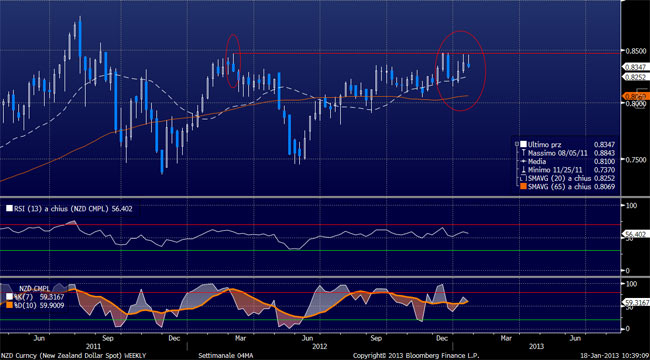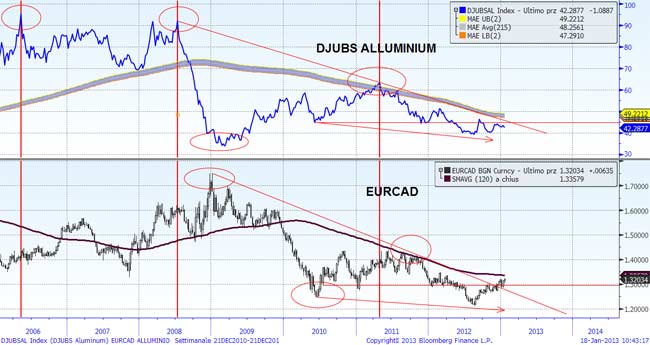Between mid-February and mid-March, the United States will break the debt ceiling and by then Obama will have to resolve the issue to avoid the default of U.S. debt. The EUR/USD change seems now affected by this uncertainty and, after having hit our target area of 1.34 (50% of the decline 2011-2012) in the short-term could provide some strength signals due to an excess of positive sentiment in financial markets.
For this reason, we enter short on NZD/USD (alternatively we might use AUD/USD) which, for the umpteenth time, is not able to overcome the barrier of 0.85. The weekly closure formalizes a shooting star, meaning that bears come back strongly on the market.
On the macroeconomic front, there will be many starting points; the only data will come from the sale of houses on January 22nd, the houses price index on January 23rd and the leading index on January 24th.
Trade: Enter short on NZD/USD at 0.8350 stop 0.8500
GERMANY IN FOCUS
Once more, Great Britain and Germany will be the protagonists of the European week. For the first one, we will be able to know the GDP of the fourth quarter of 2012 on January 25th, after the important data on unemployment scheduled for January 23rd. Instead Germany will publish the leading index IFO on January 25th after the release of another confidence index, the ZEW, scheduled for Monday 22nd.
THE BANK OF JAPAN AUTONOMY
The week begins immediately with the meeting of the Bank of Japan and it will be interesting to see on Monday 22nd if the Monetary Institute will maintain its autonomy or will be at the new Abe government disposal by starting an ultra expansive bias already incorporated into JPY prices. The next day will be all concerning the trade deficit, in red for months now, and finally the inflation on January 25th.
CAD AND ALUMINUM PRICE
The week will offer several ideas for Canada and its economy. On January 22nd, retail sales, on January 23rd, the announcement of interest rates and inflation on January 25th. However, we are concerned about the existing link between EUR/CAD and the price of aluminum. As Canada is one of the largest producers in the world, the change is strictly correlated with the price of the raw material, but in an unusual way. In fact, the price of aluminum tends to anticipate the EUR/CAD trend of a few months.
The graph shows us how the EUR/CAD top was followed six month later by the top of aluminum, and the same thing happened in April 2011. Considering that the aluminum is standing on its bottoms from months and EUR/CAD has clearly rebounded approaching the moving average at 120 weeks of 1.3357, we believe it might be worth taking advantage of this divergence going short on EUR/CAD with a stop at 1.3490.
Emerging countries
China: HSBC PMI Manufacturing (confidence index) on January 24th
Brazil: Inflation and current account deficit on January 23rd - consumer confidence on January 24th
South Africa: Inflation on January 23rd – rates announcement on January 24th
Turkey: rates announcement on January 22nd
LAST TRADES – COMMENT
XAU/USD confirms our view that a primary bottom on gold is forming so that we maintain the double long position. Positive long entry on USD/ZAR on which we adapt the stop loss to the input level. Even if we are suffering, we stay on the short position of USD/JPY as the negative sentiment on the JPY seems to be excessive.
- English (UK)
- English (India)
- English (Canada)
- English (Australia)
- English (South Africa)
- English (Philippines)
- English (Nigeria)
- Deutsch
- Español (España)
- Español (México)
- Français
- Italiano
- Nederlands
- Português (Portugal)
- Polski
- Português (Brasil)
- Русский
- Türkçe
- العربية
- Ελληνικά
- Svenska
- Suomi
- עברית
- 日本語
- 한국어
- 简体中文
- 繁體中文
- Bahasa Indonesia
- Bahasa Melayu
- ไทย
- Tiếng Việt
- हिंदी
Is The Global Devaluation Ready To Have A Break?
Published 01/22/2013, 04:12 AM
Updated 07/09/2023, 06:31 AM
Is The Global Devaluation Ready To Have A Break?
United States: Too Optimistic Between Investors?
Latest comments
Loading next article…
Install Our App
Risk Disclosure: Trading in financial instruments and/or cryptocurrencies involves high risks including the risk of losing some, or all, of your investment amount, and may not be suitable for all investors. Prices of cryptocurrencies are extremely volatile and may be affected by external factors such as financial, regulatory or political events. Trading on margin increases the financial risks.
Before deciding to trade in financial instrument or cryptocurrencies you should be fully informed of the risks and costs associated with trading the financial markets, carefully consider your investment objectives, level of experience, and risk appetite, and seek professional advice where needed.
Fusion Media would like to remind you that the data contained in this website is not necessarily real-time nor accurate. The data and prices on the website are not necessarily provided by any market or exchange, but may be provided by market makers, and so prices may not be accurate and may differ from the actual price at any given market, meaning prices are indicative and not appropriate for trading purposes. Fusion Media and any provider of the data contained in this website will not accept liability for any loss or damage as a result of your trading, or your reliance on the information contained within this website.
It is prohibited to use, store, reproduce, display, modify, transmit or distribute the data contained in this website without the explicit prior written permission of Fusion Media and/or the data provider. All intellectual property rights are reserved by the providers and/or the exchange providing the data contained in this website.
Fusion Media may be compensated by the advertisers that appear on the website, based on your interaction with the advertisements or advertisers.
Before deciding to trade in financial instrument or cryptocurrencies you should be fully informed of the risks and costs associated with trading the financial markets, carefully consider your investment objectives, level of experience, and risk appetite, and seek professional advice where needed.
Fusion Media would like to remind you that the data contained in this website is not necessarily real-time nor accurate. The data and prices on the website are not necessarily provided by any market or exchange, but may be provided by market makers, and so prices may not be accurate and may differ from the actual price at any given market, meaning prices are indicative and not appropriate for trading purposes. Fusion Media and any provider of the data contained in this website will not accept liability for any loss or damage as a result of your trading, or your reliance on the information contained within this website.
It is prohibited to use, store, reproduce, display, modify, transmit or distribute the data contained in this website without the explicit prior written permission of Fusion Media and/or the data provider. All intellectual property rights are reserved by the providers and/or the exchange providing the data contained in this website.
Fusion Media may be compensated by the advertisers that appear on the website, based on your interaction with the advertisements or advertisers.
© 2007-2025 - Fusion Media Limited. All Rights Reserved.
